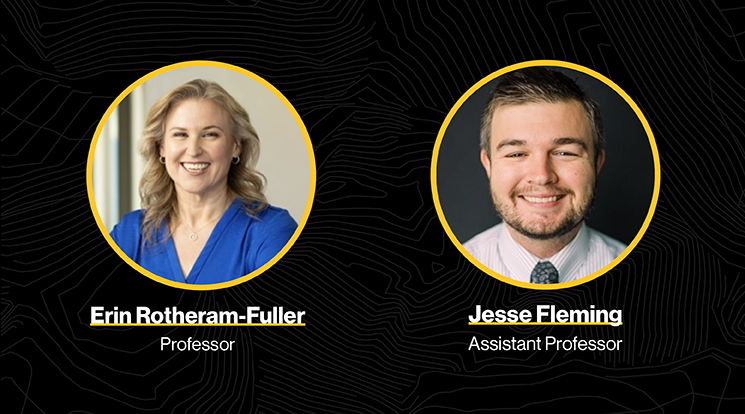Special education strategies for teachers and families

General education teachers are often the first point of connection for students whose learning and behavioral needs represent a wide spectrum, including those with disabilities. While many of these educators are eager to offer individualized support, they may lack the real-time insight and practical strategies needed to respond effectively.
To address this gap, the ASU Professional Educator Learning Hub is offering Special Education Practices for General Education Teachers, a research-informed professional learning course designed by MLFC special education experts. The fully online course is the first in a bundle of special education topics through the PELH platform. Other courses will focus on autism basics and universal-behavior support strategies for all classrooms.
Learn more in this Q&A with MLFC faculty Jesse Fleming and Erin Rotheram-Fuller, who are developing the courses, about how these insights can be of value to educators and anyone who works with youth, including family members.
Q. Why is special education training essential for general educators?
A. Rotheram-Fuller, MLFC professor: Nearly 67% of students with learning disabilities spent most of their school day in general education classrooms, according to data from the National Center for Education Statistics. While inclusion offers many benefits, it also introduces new challenges for teachers who may not have received focused training in special education practices. We've consistently heard from educators that they want practical tools — not more theory, but research-based strategies they can use right away. An additional benefit to educators is that these approaches strengthen their overall ability to develop personalized education approaches that bring benefits to all students.
Q. What skills help general educators support students with disabilities?
A. Fleming, MLFC assistant professor: This course focuses on high-leverage practices — a set of research-backed strategies proven to work across diverse student needs, including those with disabilities. First introduced in 2017 by James McLeskey and Mary-Dean Barringer, HLPs have become foundational to inclusive teaching, with strong evidence supporting their role in improving both academic outcomes and student behavior. In this course, educators are introduced to four core HLPs:
- Systematic and explicit instruction
- Universal Design for Learning
- Behavior-specific feedback
- Opportunities to respond
These practices help simplify instructional decision-making, increase teaching effectiveness, and connect directly to what teachers need in real classrooms, making them highly relevant for immediate use and long-term growth.
Q. How can educators create more inclusive and effective lessons?
A. Fleming: Inclusive instruction succeeds when it balances structure with flexibility. For example, systematic and explicit instruction offers a clear, predictable path for students by using step-by-step teaching, guided practice and regular checks for understanding. This approach is especially supportive for learners who benefit from consistency and repetition. On the other hand, Universal Design for Learning encourages flexibility by helping teachers provide multiple ways for students to access content (like visuals, audio or text), engage with materials (through group work, hands-on activities or independent study), and show what they’ve learned (using written reports, discussions or multimedia). Together, these strategies — both covered in depth in the course — make learning more personalized, accessible and responsive to all students, helping educators create classrooms where every learner has a meaningful chance to succeed.
Q. Which strategies boost engagement and academic growth?
A. Fleming: To help students stay engaged and make meaningful academic progress, teachers need tools that both encourage participation and support improvement. Feedback plays a key role. It works best when it’s timely, specific and actionable. High-quality feedback helps students recognize their progress, understand what to do next and stay motivated to keep learning. It also reinforces positive behavior and builds a growth mindset. Equally important are what’s called opportunities to respond, or OTRs, which are moments when students actively participate by answering questions, completing tasks or sharing ideas. Whether verbal, written or nonverbal, OTRs increase attention, deepen learning and allow teachers to adjust instruction in the moment. Both feedback and OTRs are core strategies taught in this course, giving educators practical ways to strengthen engagement and support every learner’s growth.
Q. How does the course ensure practical application?
A. Rotheram-Fuller: This course is designed to help educators meaningfully and quickly move from learning to doing. Rather than just reviewing strategies, participants actively apply them. They begin by reflecting on how they currently use high-leverage practices, then design an annotated lesson plan that integrates all four core HLPs, with examples of effective feedback and student response opportunities. The course wraps up with a self-assessment and reflection, helping educators identify what worked, what can be improved and how to keep building these practices into their daily teaching. The result is not just about learning new strategies, but also about putting them to work in real classrooms right away.
Q. What broader benefits does this course offer schools, districts, and families?
A. Rotheram-Fuller: Improving teacher readiness in special education strengthens the entire education system. Schools become more inclusive, districts are better prepared to meet legal requirements, and students with disabilities receive the support they deserve. Beyond schools, we’ve seen growing interest from community members and families eager to better understand how to support youth with special needs or disabilities. This course, and others in development through the ASU Professional Educator Learning Hub, offers valuable insights and strategies for anyone who works with or advocates for these learners.
ASU Professional Educator Learning Hub: Take your learning to the next level in 3 steps
- Choose your online format: Self-paced courses are available on demand. Districts interested in establishing instructor-facilitated online cohorts can also contact the ASU Professional Educator Learning Hub at [email protected]
- Sign up for the course/s:
+ Special Education Practices for General Education Teachers. Available now (with special Summer rates).
+ Universal Behavior Support Strategies. Coming soon.
+ Autism Basics. Coming soon.
Share your knowledge: Course completers earn a certificate of completion. Micro-credential options are also available to demonstrate subject proficiency.